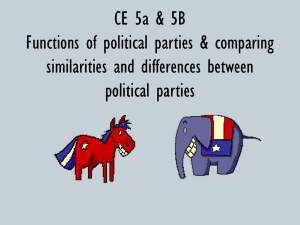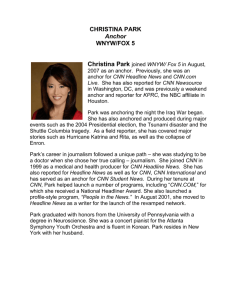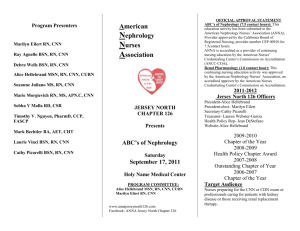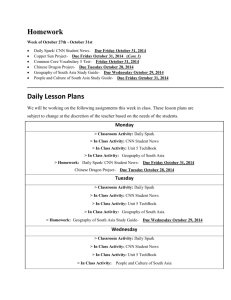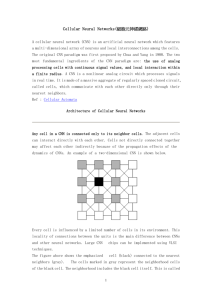VISTA (ECV)
advertisement
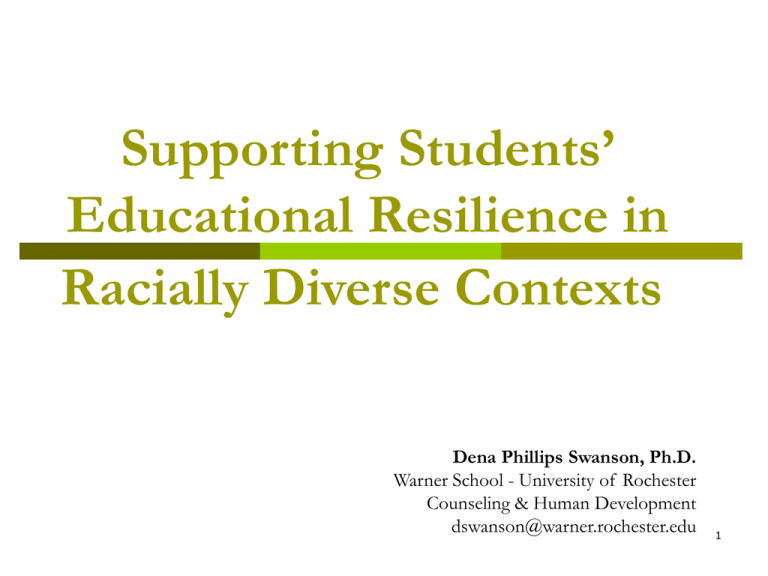
Supporting Students’ Educational Resilience in Racially Diverse Contexts Dena Phillips Swanson, Ph.D. Warner School - University of Rochester Counseling & Human Development dswanson@warner.rochester.edu 1 Introduction Presentation overview Overview of CNN’s recent “doll study” The design The findings The interpretation Children’s perspectives of race Why talk about race Strategies for shaping perspectives 2 Purpose of Research Describe – what is the issue of interest Explain – what are the processes that guide the issue Predict – what factors contribute to relevant outcomes Influence – what strategies can be implemented to change the outcome(s) Purpose of the CNN study: Describe and Explain children’s racial preferences in comparison to historical findings (and not on Predicting children’s self-esteem); Additional research conducted allows us to predict outcomes that help identify strategies for positive long term outcomes 3 Overview of the CNN Study Locations: New York, NY and Atlanta, GA Race (& Gender): Black and White children SES: schools w/ ≤30% & ≥70% free lunch Ages Early Childhood (4-5 year olds) Middle Childhood (9-10 year olds) Procedure: child’s comfort; the right to not answer any question they didn’t want to Assessments Children’s attitudes, beliefs and social preferences about skin tones using the Visual Inventory for Skin Tone 4 Assessment (VISTA) School Demographics New York City Area #1 #2 #3 #4 Free Lunch 85% 57% 10% 0% White 7% 84% 72% 7% Black 72% 7% 11% 74% School Central GA Area #5 #6 #7 #8 Free Lunch 28% 74% 98% 71% White 78% 9% 21% 70% Black 6% 76% 76% 21% School 5 Children’s Unchallenged Stereotypes Attitudes, Beliefs & Social Preferences Lighter skin tones selected most often for: positive attitudes (smart, nice, good, good looking) social preferences (classmate, friend) color preferences (skin color others like) reported more frequently by White children than Black children VISTA (ECV) - Boys Version 6 VISTA (ECV) - Girls Version Darker skin tones selected most often for negative attitudes (dumb, mean, bad, ugly) color rejection (with no racial differences) 20 out of 133 (15%) across groups indicated they would choose “none” or “they were all the same” VISTA - Color Bar http://cnn.com/video/?/video/bestoftv/2010/05/19/ac.360.panel.cnn http://cnn.com/video/?/video/us/2010/08/13/obrien.doll.marcus.cnn 7 Interpretations: Biased or Observant Children Children are not colorblind Children accurately read their environment They learn that there are color and social biases Their information is unchallenged by adults that can initiate discussions They are aware of adults discomfort They are capable of coming to their own (unchallenged yet socially informed) conclusions The consistency of omission by adults contributes to the impression that talking about race or skin color is taboo. Recognize race is not the problem but rather the attributes we ascribe to it. 8 Why Talk About Race Why not? (unsupported, but anecdotally common) Focuses on race rather than character Difficult and complicated for adults to discuss It’s irrelevant Why should we? (supported through research & practice) Provides a sense of belonging and acceptance Enhances self esteem as they learn to recognize their own, and others, attributes and values Positively shapes their relationships with others Enhances their academic and creative potential Prepares them to constructively deal with negative encounters and attitudes of others 9 Why Talk About Race Of all racial and ethnic minorities, Black children receive the least information related to racial (or cultural) validation. White children receive it through traditional history classes or have affiliations with countries of origin Latino children receive it through familial, cultural, and language traditions Asian American children receive it through cultural and family expectations Native Americans receive it through tribal affiliations 10 Schools: A Microcosm of Society Structure Expectations/Boundaries Consistency Security Behavior Performance Consequences Opportunities Enjoyment/Disappointments Belonging/Rejection Competence/Vulnerability Proverb: A stream cannot rise above it’s source 11 Demystifying Race: The F.A.C.T.S. It takes explicit and continuous effort to negate the stereotyped messages all children receive about race. Sticking to the F.A.C.T.S. Frame your message around child’s age & intent Acknowledge children’s questions, perspective, or experiences Consistency is necessary Talk it out – discuss media images - what they say and don’t say; observed messages are the most powerful sources of information Share children’s diverse cultural history with them and regularly participate in cultural activities with other groups 12 Framing Strategic Considerations Strategies for shaping perspectives are relevant, regardless of race, for: Administrators – of schools, homes, classes and businesses (managers of these contexts) Educators – in schools, homes, classes and businesses (socializes in these contexts) Strategies facilitate educational resilience a specific domain of resilience where youth have positive educational adaptations and outcomes within the context of significant adversity (children have one job – school work, but every job comes with challenges) 13 Where to from here? Work toward being proactive in contrast to reactive I’m READY: I am a Mature, Respectful, Engaged, Accountable and Determined Youth All efforts should be relatable to the students: Validating, multidimensional and empowering Offer programs to initiate new approaches and that reinforce prior initiatives – not once/year or term efforts Make existing efforts relatable to students Use existing school identity and efforts School motto Regular, brief tributes to historical figures twice a week that includes what they accomplished and what/how they overcame – students don’t generally relate to these figures 14 Motivating Students PERSEVERANCE What lies behind us and what lies before us are small compared to what lies within us DETERMINATION The ultimate GOAL should be doing your best PERSISTENCE Challenges are what makes life interesting; Overcoming them is what makes life meaningful DETERMINATION A journey of a thousand miles begins with a single step 15 Where to from here? Provide supports for collaborative networks Teachers that share student-engaging strategies With colleges to draw students from courses that can address your initiatives as part of their course requirements. Have students (1) identify challenges they feel younger students (similar to themselves in race and gender) will experience and (2) offer suggestions for helping reduce the challenges. Gives an opportunity to examine their perceptions and Explore opportunities for change 16 Age-Appropriate Considerations Frame the message- Acknowledge child - Consistency is necessary - Talk it out - Share culture Goal: Confident, competent, caring, and connected children When young – the issue is… Categorizing - “I’m not black, I’m brown” During Middle childhood, issues are… Developing skills – what I can do well Social comparisons – how others look and what they can do well Don’t assume their intent or perspective find out what makes them believe or say something derogatory when making a statement about an individual that is generalized to a group During early to middle adolescence, issues are… Defining “who I am”, how I look (identity) and where I fit in http://www.ls.cc.al.us/blackhistory/blackhistory.html 17 In closing… Over time, many children can feel isolated, confused, inferior, insecure, angry, or even entitled. In response they can become reactive in ways that are developmentally and socially unproductive. Our goal is to raise children with character that are confident, competent, connected, and caring. Among the many factors we consider in this process, their race is one that should not be ignored. 18 References Swanson, D.P., Cunningham, M., Youngblood, J., & Spencer, M.B. (2008). Racial Identity During Childhood. In the Handbook of African American Psychology (pp. 269-281). New York: Sage. Visual Inventory for Skin Tone Assessment (VISTA) Thanks to: •CNN AC360° for conducting and reporting the story; •Drs. Tabitha Del’Angelo and Margaret Spencer as co-collaborators on the study 19

